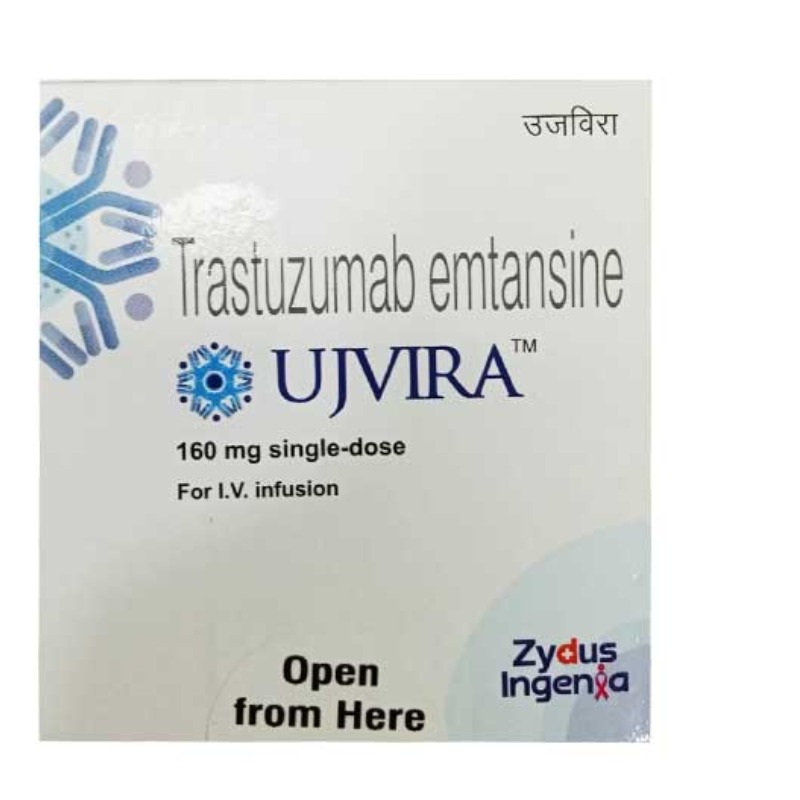DESCRIPTION
MECHANISM OF ACTION
• Recombinant humanized monoclonal antibody directed against the extracellular domain (IV) of the HER2 growth factor receptor. This receptor is overexpressed in several human cancers, including 25%–
30% of breast cancers and up to 20% of gastric cancers.
• Precise mechanism(s) of action remains unknown.
• Inhibits HER2 intracellular signaling pathways.
• Immunologic mechanisms may also be involved in antitumor activity, which include recruitment of antibody-dependent cellular cytotoxicity
(ADCC) and/or complement-mediated cell lysis.
DISTRIBUTION
Distribution in body is not well characterized.
INDICATIONS
1. Metastatic breast cancer—First-line therapy in combination with paclitaxel. Patient’s tumor must express HER2 protein to be treated with this monoclonal antibody.
2. Metastatic breast cancer—Second- and third-line therapy as a single agent in patients whose tumors overexpress the HER2 protein.
3. Early-stage breast cancer—FDA-approved for the adjuvant therapy of node-positive, HER2-overexpressing breast cancer as part of a treatment regimen containing doxorubicin, cyclophosphamide, and either paclitaxel or docetaxel.
4. Metastatic gastric and gastroesophageal junction adenocarcinoma— FDA-approved in combination with cisplatin and capecitabine or 5-FU for the treatment of patients with HER2-overexpressing metastatic gastric or gastroesophageal junction adenocarcinoma who have not received prior treatment for metastatic disease.
DOSAGE RANGE
1.Recommended loading dose of 4 mg/kg IV administered over
90 minutes, followed by maintenance dose of 2 mg/kg IV on a weekly basis. One week following the last weekly dose of trastuzumab, administer trastuzumab at 6 mg/kg as an intravenous infusion over 30–90 minutes every 3 weeks.
2.Alternative schedule is to give a loading dose of 8 mg/kg IV administered over 30–90 minutes, followed by maintenance dose of 6 mg/kg IV every
3 weeks.
3.Administer trastuzumab, alone or in combination with paclitaxel, at an initial dose of 4 mg/kg as a 90-minute intravenous infusion followed by subsequent once-weekly doses of 2 mg/kg as 30-minute intravenous infusions until disease progression.
4.Administer trastuzumab at an initial dose of 8 mg/kg as a 90-minute intravenous infusion followed by subsequent doses of 6 mg/kg as an intravenous infusion over 30–90 minutes every 3 weeks until disease progression.
DRUG INTERACTIONS
Anthracyclines, taxanes—Increased risk of cardiotoxicity when trastuzumab is used in combination with anthracyclines and/or taxanes.
SPECIAL CONSIDERATIONS
1.Caution should be used in treating patients with preexisting cardiac dysfunction. Careful baseline assessment of cardiac function (LVEF) before treatment and frequent monitoring (every 3 months) of cardiac function while on therapy. Trastuzumab should be held for > 16% absolute decrease in LVEF from a normal baseline value. Trastuzumab therapy should be stopped immediately in patients who develop clinically significant congestive heart failure. When trastuzumab is used in the adjuvant setting, cardiac function should be assessed every
6 months for at least 2 years following the completion of therapy.
2.Carefully monitor for infusion reactions, which typically occur during or within 24 hours of drug administration. Administer initial loading dose over 90 minutes,
and then observe patient for 1 hour following completion of the loading dose. May need to treat with diphenhydramine and acetaminophen. Rarely, in
severe cases, may need to treat with IV fluids and/or pressors.
3.Maintenance doses are administered over 30 minutes if loading dose was well tolerated without fever and chills. However, if fever and chills
were experienced with the loading dose, maintenance doses should be administered over 90 minutes
.
4.Pregnancy category D.
TOXICITY 1
Infusion-related symptoms with fever, chills, urticaria, flushing, fatigue, headache, bronchospasm, dyspnea, angioedema, and hypotension. Occur in
40%–50% of patients. Usually mild-to-moderate in severity and observed most commonly with administration of the first infusion.
TOXICITY 2
Mild GI toxicity in the form of nausea/vomiting and diarrhea.
TOXICITY 3
Cardiotoxicity in the form of dyspnea, peripheral edema, and reduced left ventricular function. Significantly increased risk when used in combination with
an anthracycline-based regimen. In most instances, cardiac dysfunction is readily reversible.
TOXICITY 4
Myelosuppression. Increased risk and severity when trastuzumab is administered with chemotherapy.
TOXICITY 5
Generalized pain, asthenia, and headache.
TOXICITY 6
Pulmonary toxicity in the form of increased cough, dyspnea, rhinitis, sinusitis, pulmonary infiltrates, and/or pleural effusions.
SPECIFICATION


Login To Comment